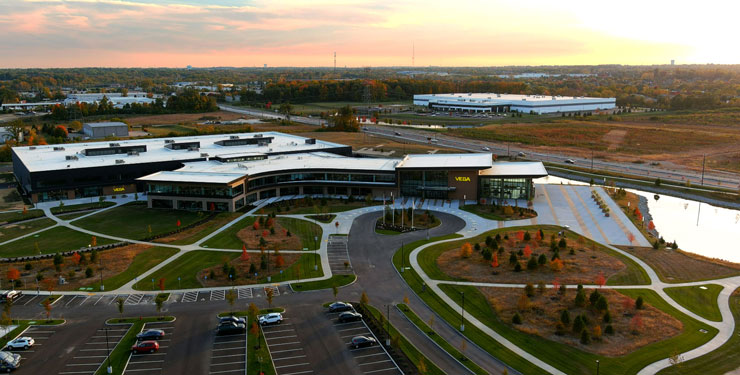
Bridging Finance and Sustainability

As the world pivots towards a more sustainable future, the intersection of finance and environmental responsibility becomes increasingly crucial. The Midwest Regional Sustainability Summit 2024, themed "From Vision to Action," provided an excellent platform for discussions that align with BHDP’s commitment to design for people. Alongside our clients, we are responsible for leading the way in integrating these paradigms, pushing the boundaries of what it means to be both financially savvy and environmentally responsible, and championing a more sustainable tomorrow. My colleague, Daniel Lessing, and I attended the summit together, and it not only reinforced our commitment to sustainability and financial acumen but also illuminated the path forward.
A Bright Future
The summit kicked off by celebrating the Sunrise Movement and highlighting the electrification and solar panel initiatives led by students in the Cincinnati Public School system. Students collaborated with teachers and the board to get approval and funding for the implementation of solar panels on their schools, receiving a unanimous “yes” from the board. This powerful start underscored the summit's emphasis on intergenerational collaboration—where youth and experience come together for a common cause. It's a poignant reminder that sustainability transcends age and profession.
The Financial Backbone of Sustainability
The breakout session "Advancing Clean Energy Finance" shed light on the critical role of finance in achieving sustainable goals, chiefly surrounding federal funding through the Inflation Reduction Act (IRA), the Bipartisan Infrastructure Law (BIL), and the Creating Helpful Incentives to Produce Semiconductors (CHIPS) Act. With panelists like Christina O’Keefe from the Ohio Air Quality Development Authority (OAQDA) and Tom Hucker, Senior Consultant of the US Department of Energy, discussing the influx of federal funding through the IRA, BIL, and CHIPS Acts, it was evident that the path to sustainability is paved with collaborative efforts. The notion that “for every $1 invested in OAQDA projects, there is $16 created in societal value for Ohioans,” as noted by O’Keefe, is a testament to the tangible benefits of investing in sustainability from both a financial and societal perspective.
Moreover, the discussion highlighted a crucial shift in the approach to grants. Executive Director of Sustainable Ohio Public Energy Council, Luke Sulfridge, compared the influx of federal funding to "drinking from a firehose.” The lack of existing infrastructure to support this flood of incoming money has emphasized the necessity for collaborative efforts to leverage these opportunities fully. Hucker described the IRA, BIL, and CHIPS as a "grand repositioning" of the American economy aimed at healing the disenfranchised industrial cities of the Rust Belt through sustainable development. This repositioning is not just about economic rejuvenation; it's a pathway to healing communities and laying the groundwork for a sustainable future.
The panel's consensus on collaboration over competition to maximize these funds reflects a cultural shift towards unified action for a renewable future. This approach aligns with BHDP's mission and offers a blueprint for how we can guide our clients and projects toward making the most of available resources for sustainable development.
Embracing Technology for Sustainable Infrastructure
The session "Imagination and Action: IoT and AI for More Sustainable Facilities and Infrastructure” highlighted the transformative potential of technology in the realm of sustainability, focusing on the roles of the Internet of Things (IoT) and artificial intelligence (AI). For those unfamiliar with the term, the Internet of Things refers to a network of interconnected devices that communicate and exchange data via the internet. Kris Brannock, the Executive VP of Vertical Solutions Inc.'s Actionable IoT, and Jerry Schmits, Comprehensible Solutions Manager at Trane Technology, elaborated on how applying predictive intelligence and continuous performance monitoring could usher in a new era in building management. This technological advancement promises to redefine our understanding of AI's role in enhancing sustainability practices.
The potential for predictive intelligence to automate and optimize building systems, ensuring efficiency and preempting failures, is particularly relevant. This speaks to sustainability in terms of energy use and addresses the broader context of operational sustainability amidst labor shortages as we see an increase in the current labor force going into retirement while birth rates remain relatively low.
A Vision for Our Clients
The insights I gathered from the summit are more than just narratives; they are actionable strategies that BHDP can employ in our quest to serve our clients with the latest and most effective solutions for sustainable and financially sound architecture.
As I reflect on the wealth of knowledge and perspectives shared at the Midwest Regional Sustainability Summit 2024, it's clear that the journey from vision to action in sustainability is intertwined with innovative financial strategies and technological advancements. At BHDP, we are committed to embodying these principles, guiding our clients, and leading by example in the architectural domain.
By embracing collaborative approaches, strategically leveraging federal funding, and incorporating cutting-edge technologies, we can navigate the challenges of today and tomorrow, ensuring a sustainable, profitable future for all.
Let's talk sustainability. Complete our contact form today.
Author
Content Type
Date
May 30, 2024
Topic
Conferences



